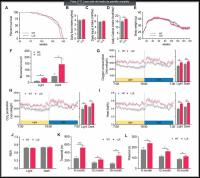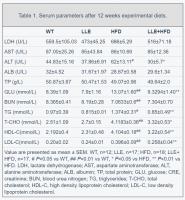.
O P E N A C C E S S S O U R C E : AgING
Abstract
Numerous epidemiological studies have reported that moderate alcohol drinking has beneficial effects. However, few studies have focused on the beneficial effects of ethanol, the common component in alcoholic beverages. Here we fed the C57BL/6 mice with 3.5% v/v ethanol as drinking water substitute to investigate the effects of long-term low-dose ethanol intake in vivo. We evaluated the metabolic rate and mitochondrial function of the long-term low-dose ethanol-intake (LLE) mice, assessed the exercise ability of LLE mice, and fed the LLE mice with a high-fat diet to investigate the potential impact of ethanol on it. The LLE mice showed improved thermogenic activity, physical performance, and mitochondrial function, as well as resistance against the high-fat diet-induced obesity with elevated insulin sensitivity and subdued inflammation. Our results suggest that long-term low-dose ethanol intake can improve healthspan and resist high-fat diet-induced obesity in mice. It may provide new insight into understanding the protective effects of moderate alcohol drinking.
Introduction
Alcoholic beverages among the most common worldwide beverages in people’s daily life. As the common component of beer, wine and liquor, alcohol or ethanol, is controversial on the risk-benefit balance of consumption. In many studies, excessive consumption of alcohol has been proved to be associated with increased risks in more than 60 types of diseases, such as cardiovascular disease, alcoholic liver disease, and cancer [1, 2]. As a result, the harmful effects of drinking are commonly concerned, whereas the benefits of moderate alcohol consumption are less appreciated. Recently, some epidemiological studies showed that moderate alcohol intake could lower all-cause mortality compared to non-drinkers and heavy drinkers [3–5]. Further epidemiological reports suggested that moderate daily alcohol intake might reduce the risk of cognitive decline in women and promote the release of brain acetylcholine [6, 7]. Multiple studies have also shown that moderate drinking has cardiovascular protective effects and is linked to reduced risks of heart failure [8, 9]. Regrettably, concerned predominantly with the risks of excessive alcohol consumption, scientists have paid little attention to the beneficial effects of moderate alcohol intake. Determining the benefits of moderate alcohol intake is therefore important for people to drink safely and healthily without having alcohol-related issues.
Obesity is a leading cause of morbidity and mortality worldwide. Overweight and obesity trigger metabolic disorders that are accompanied by manifestations such as dyslipidemia, insulin resistance, and chronic systemic inflammation [10]. Obesity is also associated with increased risks of cardiovascular disease and other age-related diseases [11]. All of the abovementioned diseases caused by obesity bear adverse impacts on health and generally reduce lifespan. Intriguingly, epidemiologic studies showed the fact that moderate alcohol intake is linked to lower risks of cardiovascular disease and metabolic-related disease [4, 9, 12, 13]. This raises the possibility of a beneficial role for moderate alcohol intake in other age-related diseases. Some previously published studies have suggested that moderate consumption of 30 g/d of alcohol (2 drinks per day) is beneficial to insulin sensitivity and triglyceride concentration in nondiabetic postmenopausal women and could decrease the risk of diabetes and improve insulin resistance [14, 15]. In another study, Wang et al. observed an inverse relationship between moderate alcohol consumption and the risk of becoming overweight or obese in a cohort of middle-aged and older women during 12.9 years of follow-up [16]. However, there is still no definitive answer to whether ethanol plays a key role in these beneficial processes.
Despite the progress in the epidemiological research, there have been few studies showing the effectiveness of moderate alcohol intake on the improve healthspan in mammals, leading us to study chronic low-dose ethanol supplementation in laboratory mice. Our previous study has shown that chronic moderate alcohol intake accelerates SR-B1 mediated reverse cholesterol transport [17]. We subsequently hypothesized that moderate alcohol intake might improve the physical condition of mice. Cohorts of male C57BL/6 mice were provided with a standard diet or an otherwise equivalent high-fat diet (HFD, 45% of caloric fat), each diet supplemented with 3.5% ethanol from week 8 to the end of life. The physical and physiological performances of long-term low-dose ethanol intake (LLE) mice were evaluated in this research.
Results
Long-term low-dose ethanol intake increases thermogenic activity and improves physical performance of mice
To determine the long-term effects of moderate ethanol intake in mice, the drinking water was supplemented with 3.5% (v/v) ethanol from 8 weeks after birth until the end of life. The survival curve of the LLE mice was slightly shifted to the right (Figure 1A), leading to a 4.42% extension of mean lifespan (Chi square=5.896, P=0.0152, in Gehan–Breslow survival test). Thorough post mortem anatomical and histopathological studies did not show noticeable differences between the LLE mice and the WT mice in their pathology or cause of death. Neither were their plasma ALB, TP, ALT, AST, or BUN levels significantly different, indicating comparable organ functions (Table 1). In comparison, our previous studies showed that a high-level ethanol intake (15% v/v) could cause the elevation of ALT and AST, and induce alcoholic fatty liver disease [18–20]. While cognition and learning which can be impaired by a large amount of alcohol intake, water maze test indicated that the cognitive ability of the LLE mice was slightly improved (Supplementary Figure 1A–1D). The LLE mice did not show the cognitive impairment that alcoholism might have caused, and instead exhibited signs of improved cognition that was reported previously [6].
Figure 1. Increased thermogenic activity and improved physical performance in LLE mice. (A) Kaplan-Meier survival curve for long-term low-dose (3.5% v/v) ethanol intake (LLE) mice and untreated wild-type (WT) mice. (n=60 for each group). (B–D) Daily food intake, daily liquid intake, and daily calorie intake of 32-week-old LLE and WT mice (n=25 for each group). (E) Change in body weight (n= for each group). (F) X-axis movement of 44-week-old LLE and WT mice, an indicator of spontaneous locomotor activity in CLAMS system (n=8 for each group). (G–J) Oxygen consumption rate, CO2 production rate, energy expenditure rate, and respiratory exchange ratio (RER) of 44-week-old LLE and WT mice (n=8 for each group). (K–L) Distance run on treadmill and time to fall from an accelerating rotarod measured at 8, 12, 18 months, (n=10 for each group) Data are presented as mean ± SEM. *, P<0.05, **, P< 0.01, ***, P<0.001.
Table 1. Serum parameters after 12 weeks experimental diets.
To determine if low-dose ethanol intake influence the dietary habit, the daily food and liquid intake was recorded. There were no noticeable differences between the two groups in the dietary habit (Figure 1B, 1C), but the calorie intake of LLE mice was slightly higher than WT mice (Figure 1D) because the ethanol can be a source of energy. Intriguingly, the higher calorie intake did not lead to weight gain in LLE mice (Figure 1E). However, it led us to wonder if the daily activity of mice was altered. Comprehensive Lab Animal Monitoring System was subsequently used to monitor mice activity and metabolic rates. With the supplement of ethanol, the LLE mice tend to be more active (Figure 1F). The higher oxygen consumption (Figure 1G), carbon dioxide production (Figure 1H) and heat production (Figure 1I) in both light phase and dark phase indicated that the basal metabolic rates of the LLE mice increased. Also noteworthily, the respiratory exchange ratio (RER) of two groups are almost the same (Figure 1J), suggesting comparable rates of oxidation of fat and carbohydrates in this state.
Given the appreciable effects of long-term low-dose ethanol intake on the metabolic rate, it was necessary to determine whether the physical performance, which reflects the state of health, was preserved in the LLE mice. One way to assess this was to measure endurance and motor coordination, which we examined by using a rotarod and a treadmill. Interestingly, our observations showed that the LLE mice performed significantly better than WT mice (Figure 1K, 1L). These results indicate that the long-term low-dose ethanol intake will enhance the physical performance of the mice rather than impair it.
Long-term low-dose ethanol intake enhances the mitochondrial function of mice
Increased daily activity and improved physical performance of the LLE mice implied enhanced mitochondrial function. We next examined the mitochondria in liver and muscle using electron microscopy. A markedly increased number of mitochondria in the liver and gastrocnemius muscle of LLE mice was observed in the images, displaying visibly larger mitochondrial structures with an increased presence of cristae in the LLE mice (Figure 2A–2C). Mitochondrial DNA (mtDNA) content was also quantified by PCR. As expected, mtDNA markedly increased in the LLE mice (Figure 2D). To further evaluate the mitochondrial function of the LLE mice, the oxygen consumption rate (OCR) of the liver and the muscles were examined. The basal oxygen consumption rate was elevated in the muscles of the LLE mice (Figure 2E). Following the addition of oligomycin and FCCP, the muscles of LLE mice showed an increased ATP production and maximal respiration (Figure 2F, 2G). Spare respiratory capacity (SRC), the extra mitochondrial capacity available in cell to produce energy under conditions of increased work or stress, was also slightly increased (P=0.06, Figure 2H). Taken together, these results indicate that mitochondrial function was enhanced under the long-term ethanol treatment in the LLE mice.
.../...
.
















































